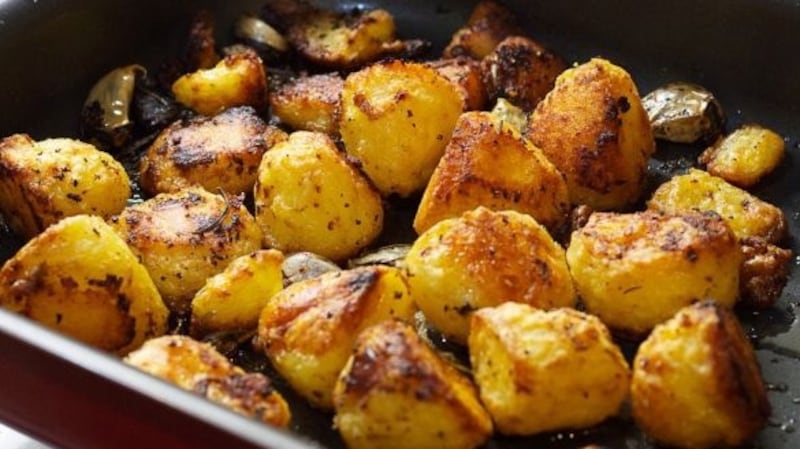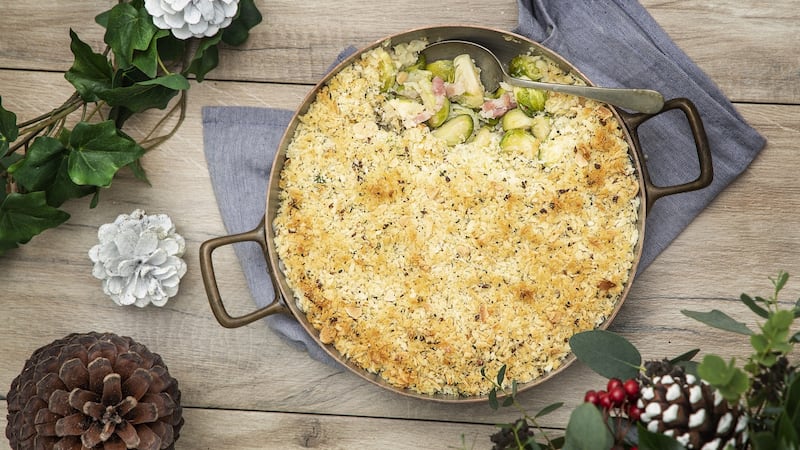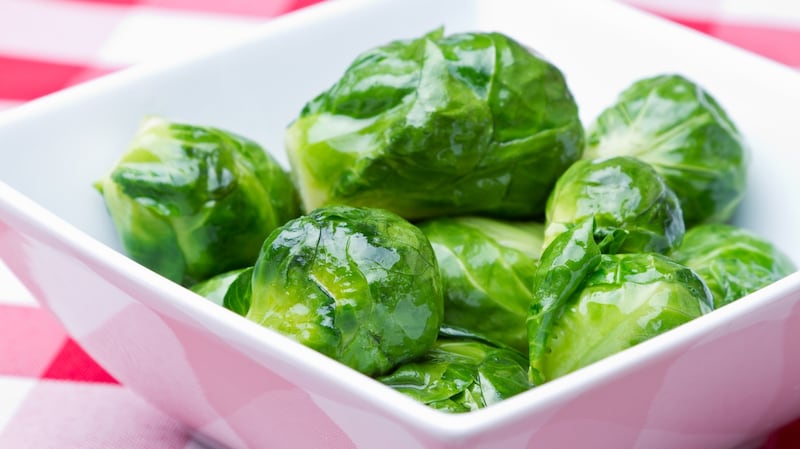There are people, believe it or not, who make three kinds of potato to serve with Christmas dinner. Roasties are essential, mash should be optional, but if you even consider adding croquettes, you really are going overboard. A good roast potato, or two, should be all that’s needed, along with the obligatory sprouts.
Floury potatoes make the best roasties and Maris Piper are reputed to be the best variety for roasting, but Roosters will do fine.
This type of potato will give you a satisfyingly rough surface when you’ve par-boiled them and given them a good shake against the sides of the pot. It is here in the craggy edges that the cooking fat will adhere, giving an extra crunchy finish once they have been roasted.
Some suggest rolling par-boiled potatoes in olive oil, then in fine polenta, for even more crunch. They can be prepared to this stage on December 24th then refrigerated overnight, and finished in a hot oven while the turkey is resting. A good plan for those with small ovens.

Chef and Irish Times recipe columnist Grainne O’Keefe gives her roast potatoes an extra savoury kick, with the addition of miso butter. The potatoes are parboiled, roasted in olive oil or vegetable oil, then given a final annointing with melted butter and miso paste mixed together.
Olive oil, beef dripping and goose or duck fat are popular choices for roasting potatoes. Whichever you choose, make sure to heat the fat in the oven before adding the potatoes to the dish. A good sizzle when spud hits oil is what you want to hear.
Here is a step-by-step method from The Irish Times recipe archive for roast potatoes cooked in goose fat. The frying step is optional, but it does increase the crunchy outer to creamy inner ratio, if that’s your preference in a roast potato.
Potatoes roasted in goose fat with garlic and thyme

1. Pre-heat an oven to 180 degrees/gas four. Peel the spuds and chop them into quarters. Cook in boiling salted water until part-cooked, but still holding their shape. Drain and put them back in the saucepan to dry out, with a tea towel on top.
2. In a large frying pan, melt the goose fat along with the cloves of unpeeled garlic and salt. Remove the garlic with a slotted spoon when it starts to colour and place it on a baking tray. Fry the potatoes in batches until they are golden brown and crisp on all sides.
3. Transfer the potatoes to the baking tray and spoon over a bit of the goose fat, then sprinkle with thyme. Bake in a hot oven for another 10-15 minutes with the garlic and thyme. When ready to serve, sprinkle with a bit more sea salt.
You can prep these ahead of time, by frying them and setting them aside overnight. Just give them a final blast in the oven to heat through and crisp up before serving.
Perfect sprouts
It wouldn't be Christmas, for most folk, without a few Brussels sprouts. When buying them look out for the ones sold on the stalk, advises vegetable growing consultant Dermot Carey. They will stay fresh longer, and are kinder to those hardy folk doing the harvesting at this time of year too.
“Sprouts on the stalk do not dry out as quickly. They are also much easier to harvest. I remember hand picking sprouts for Christmas as a teenager. It must have been the coldest job on the farm. Better to pick individual sprouts in the comfort of a kitchen, rather than a cold and frosty field,” Carey says.
Standing the stalks, which you have trimmed at the base, in cold water, will keep them as fresh as possible until it is time to cook them.
Paul Flynn’s Brussels sprouts gratin

Ingredients
1 packet smoked bacon lardons
750g sprouts, trimmed, washed and shredded
1 tbsp duck fat
Pinch of sugar
Salt and pepper
3 tbsp water
250ml cream
150g breadcrumbs
Zest of half a lemon
50g butter, melted
6 leaves fresh sage, chopped
80g Gruyère cheese (or similar), grated
Method
1 Preheat an oven to 170 degrees Celsius, or equivalent.
2 Sauté the bacon in a little of the duck fat until it is golden.
3 Transfer the bacon to a shallow casserole along with the sprouts, remaining duck fat, sugar and a little salt.
4 Pour the cream and water over the top. Mix well.
5 Bake in the oven for 15-20 minutes until the sprouts are just tender.
6 Mix the breadcrumbs with the lemon zest, melted butter, sage, and Gruyère cheese. Season with salt and pepper and sprinkle over top of sprouts.
7 Bake for 12-15 minutes, until crusty and golden.
Paul Flynn’s Brussels sprouts with Cidona

As a love token, the little green globes are an unusual choice, but Paul Flynn, chef-patron of the Tannery restaurant in Dungarvan, Co Waterford once drove 15 miles on Christmas day to deliver some to his sprout-loving future wife, Máire, whose family didn’t share her enthusiasm for them. Imagine that. No wonder she married him.
Cidona may sound strange in this recipe, but when you think about it, it makes sense: the sweetness of the drink tempering the vegetable’s bitterness.
Ingredients
Serves eight
675g Brussels sprouts, trimmed
50g butter
300ml bottle Cidona (if you can’t find Cidona use 7UP)
Salt and freshly ground black pepper
Method
1. Place the sprouts in a pan of boiling salted water and bring to the boil, then reduce the heat and simmer gently for five minutes until just tender. Drain and quickly refresh under cold running water. Place in a bowl and cover with cling film until needed - this can be done up to 24 hours in advance.
2. Heat a saute pan and add the butter. Once foaming, tip in the blanched sprouts and sauté on a medium heat, turning every now and again until they start to lightly brown. Pour in the Cidona, increase the heat and simmer until all the liquid has absorbed into the sprouts, shaking the pan a couple of times. Season to taste and tip into a warmed serving bowl to serve.
Lilly Higgins’s festive greens

As an alternative, or an addition to the sprouts, Lilly Higgins suggests serving a platter of citrus spiked green vegetables – broccoli, green beans, asparagus and mangetout. She also has a clever tip to follow if carrot and parsnip mash features in your Christmas dinner: add a few whole star anise to the cooking water (remove before mashing).
Ingredients
Serves six
3 tbsp olive oil
3 tbsp lime or lemon juice
2 tbsp coriander, finely chopped
1 clove garlic, crushed
Pinch of salt
Pinch of chilli flakes (optional)
1 head of broccoli, broken into bite-size florets
200g green beans
150g mangetout
1 bunch asparagus
Method
1. Place the crushed garlic, olive oil, lemon juice and sea salt into a large bowl. Whisk well to combine. Add the finely chopped coriander and the chilli flakes if using. Set aside.
2. Bend the asparagus till the woody end snaps off. Cut into large bite-size pieces. Bring a large pot of salted water to the boil. Add the broccoli and green beans. Simmer for about three minutes before adding the asparagus for a further two minutes and add the mangetout for the final minute. Cook them until they still retain a little bite. Drain over the sink and rinse with cold water to stop the vegetables from cooking any further.
3. Ensure you shake off as much excess water as possible then tip the vegetables into the bowl with the dressing. I find it easiest to mix with my hands but you can use a large spatula or spoon to fold everything together gently so the vegetables glisten with dressing. Serve right away or cool to room temperature.
Saucy sides
For many people, a good homemade turkey gravy, and maybe a dollop of cranberry sauce from a jar, is all the saucing that a traditional Christmas dinner requires. For others, it just wouldn’t be complete without bread sauce, that anaemic amalgam of bread and milk. It’s not part of my Christmas tradition, and I’m mildly disturbed by it. Can you tell?
A colleague swears by the dried, packet versions, which you'll find in supermarkets. But it is simple to make from scratch, if you must. For a recipe for this rather odd mixture of white breadcrumbs, milk, spices, onion and butter, we had to look outside the Irish Times recipe archive, and who better to consult than Nigella. Her traditional bread sauce recipe, given to her by her mother, is a luxurious version, with full-fat milk and added cream. You'll find it online here.
Eunice Power’s cranberry and orange sauce

Cranberry sauce from a jar is what most of make do with, but if you want to make your own, it’s as easy as pie. Here is Eunice Power’s version.
Ingredients
300g fresh cranberries, rinsed
200g sugar
150ml orange juice
100ml water
1tsp freshly grated ginger
Method
1. Place the cranberries, sugar, ginger, orange juice and water in a medium saucepan. Cook over a gentle heat and let the mixture come to the simmer until the cranberries start to burst.
2. Simmer for 10 minutes, stirring often to prevent cranberries from sticking to the bottom of the pan.











